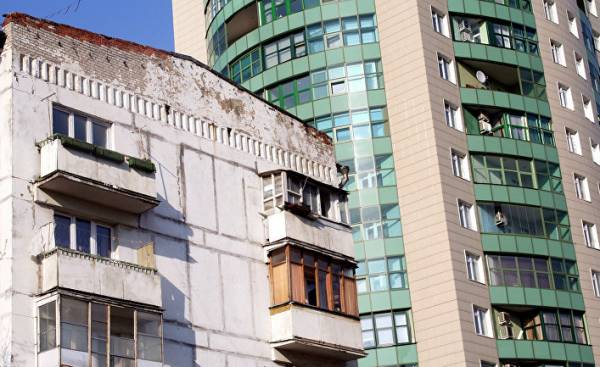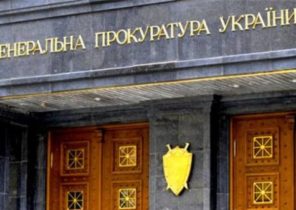
In the 1970-ies engineer Evgeny Rudakov lived in a Moscow communal apartment with 30 neighbors, so “we always had a queue to the toilet”. Then he also stood in line to receive individual flats from the Institute in which he worked.
One day came his turn, and he and his wife received two-room apartment at ulitsa Grimau, the house 16. This four-storey building with 64 apartments built in 1957, was one of the first “Khrushchev” — typical houses in several floors, which tens of thousands were built throughout the Soviet Union, and later received the nickname in honor of then Soviet leader Nikita Khrushchev. (“Khrushchev” began to call almost all five-storey building, built in the Soviet era.)
Now the house 16 on the street Grimau — along with another 7900 residential buildings in Moscow, built in Soviet times — will be demolished within the largest program of resettlement of urban residents in history. With the support of President Vladimir Putin, Moscow mayor Sergei Sobyanin said that the programme is absolutely necessary to upgrade the housing stock of the capital. He promised that those apartments where residents will be relocated Khrushchev, will be on average 20% more than their previous apartments.
However, Rudakov sure that this program is another example of an attempt to capitalize on the heritage of the people. “This is the first house that was built by Khrushchev. Now nobody respects or cares for this, he said, referring to his house. — Now the most important is money.” In his words, he “does not know why Putin ordered to” tear down these houses. “This is a very nice house, he’s got thick walls”.
Many residents supported the point of view Rudakova, expressing fears that the government will build many high-rise buildings, destroying the comfortable and cozy areas, and moved people very far from their current place of residence. According to them, many of Khrushchev can be fixed and updated. But analysts believe that the basis of this program are relocation policy and the desire to obtain sizeable profit.
Moreover, the Federal law which should provide the authorities of Moscow the right to the demolition of entire neighborhoods and the relocation of their residents, can have very disturbing consequences for the rights of residents and small business owners. People who do not sign the agreement to transfer their rights of ownership of the apartment for two months, have to go to court. “People just survive, as under Stalin,” said the activist Lena Bogush.
Opposition activist and former State Duma Deputy Dmitry Gudkov said that such a law would allow the government to demolish not only the model panel and brick houses, but nearby “similar” buildings. On the question of how decisions will be made relative to the nearby buildings, the author of the bill Deputy Mikhail Degtyarev said in an interview with TV channel “Rain” that the Council at city hall will simply be to endure them, because they don’t fit in: “you Take a neighborhood and that’s so punk”.
“This law allows us to implement the program is not in the interests of citizens and the interests of the construction lobby,” Gudkov explained.
Since the appointment of Sobyanin for mayor of Moscow in 2010 has started in the capital of several major projects for urban development. During this time, has been updated Gorky Park, opened the Moscow ring railway and launched the 120-billion program to upgrade the capital’s streets. The city authorities actively engaged in the demolition and restructuring of huge industrial areas, the remaining from Soviet times.
However, the program of renovation of five-story building in Moscow — city authorities use such a euphemism for this process — will be the most ambitious project. Although the city authorities still need to approve a list of buildings slated for demolition, Sobyanin has promised that it will be demolished 25 million square meters of residential real estate is more than 10% of the housing stock of the capital. About 1.6 million residents will be relocated. According to representatives of the city authorities of Moscow will spend at least 300 billion rubles, however, independent experts argue that the volume of investments will reach 3 trillion rubles.
What kind of home will replace the Soviet Khrushchev, is still unclear. The chief architect of Moscow refused to comment on the situation, and the mayor’s office requested questions in writing but they have not answered.
Khrushchev, who was widely distributed throughout the Soviet Union, became clear evidence of radical change in Soviet politics and culture. Under Joseph Stalin the architecture was to demonstrate the greatness of the Soviet Union through the large-scale forms, so new apartment buildings were built on individual projects, it was a beautiful and tall brick building with spacious apartments, inhabited mostly by representatives of the Soviet elite. The bulk of the population lived in the old barracks and overcrowded communal apartments where people were forced to share toilets, bathrooms and kitchens with many neighbors. After coming to power, Khrushchev said that buildings built in the previous 20 years were full of expensive architectural flourishes, “causing significant damage to the national economy and hindering the improvement of housing and cultural and community conditions of workers”. Instead, the state should build a simple model home that can be erected quickly and at the lowest possible cost to provide separate housing for every family in the Soviet Union.
Thus began a 30-year housing boom, which in its scope is unprecedented in history. It marked a new, industrial approach to construction: in Cheryomushki, where he lives Rusakov, have tried several different types of standard houses and residential planning area to minimize through traffic flow and to allocate the maximum possible area under green spaces. The same was done across the country.
Brigade, working mainly with concrete panels and other components made in factories, competed in the speed of erection of multi-storey buildings. One team managed to build a house in 11 days. According to the Russian statistics service, the share of housing built by the state rapidly grew from 26.9 million square feet during the second five-year plan (1933-1937) to 152,2 million square meters in the years 1956-1960 and of 227.2 million square meters in the years 1966-1970. From 1955 to 1964, a quarter of the population of the Soviet Union or 54 million people got their own apartment. By 1975, the state has built a 1.3 billion square meters of housing, and it continued large-scale construction of residential houses until the collapse of the Soviet Union.
For the first time in history a great many people have their own housing in the city. This large-scale resettlement became the reason of sharp growth of quality of life, many changes in everyday habits and cultural changes that formed the basis for a number of works of art, including the Opera of Dmitry Shostakovich’s “Moscow, Cheryomushki”, named after the area where was built the first Khrushchev. “Here is our front, that hanger is ours / Our kitchen is also our, our room, our. / All ours, ours!” sing the main characters of the film in 1962, based on the operetta.
According to Olga Kazakova, Director of the Institute of modernism and the candidate of art criticism, the theory is that along with Khrushchev’s policy of de-Stalinization, a personal space that’s built up by Khrushchev, was in the 1960-ies the growth of dissident activity, including samizdat.
Moreover, the density of population in the new districts was quite low, and common areas and green zones have allowed people to communicate more with each other, according to Nikolay Erofeev, who is studying philosophy at Oxford and wrote a thesis on post-war Soviet housing. He is also the owner of the apartment in the Khrushchev, that, most likely, will be demolished.
Of course, such housing mass production had shortcomings. Being the embodiment of the idea of exceptional functionality in the architectural sense, Khrushchev was boring and impersonal: rectangular, five-storey boxes arranged at the same distance from each other Windows, balconies and flights of stairs. There were low ceilings, and the area of one-bedroom apartments did not exceed 30-33 square meters, while the area of two-bedroom apartments accounted for 33-45 meters. From elevators, garbage chutes had to dismiss as a costly extravagance. Sounded a lot of complaints about the quality of insulation and heating in the winter months. In some blocks there was a very strange innovations, such as, for example, a tiny niche under the window in the kitchen, in the area where the wall thickness was only a few centimetres which was to serve as a kind of refrigerator in the cold months of the year.
The government hoped that the building will last about 25 years. Most of them have served much longer. Former dentist Sofa Schoolboy, who lives with her husband Felix in the five story building, built in 1962, says that in the winter they have the heat in the apartment and that they almost don’t hear the neighbors. Their house is surrounded by Apple, cherry and pear trees, between which there are several playgrounds, made the list of houses slated for demolition. The student fears that they will be resettled in high-rise building or that they will have to move far from their daughters, granddaughters and great-granddaughters who live nearby. (The city authorities have promised to resettle the people in the house inside their areas, however they are quite extensive and uncomfortable areas of life.)
“I like the modest home of a small building, close to the ground so I could look out the window and see trees and people,” she said over tea in his tiny kitchen, where beside her on the stove stood a pot of soup. According to her, because their house had recently changed all the water pipes, their house “can still serve”.
But Felix noted that the sewer pipe was never replaced, and that over the last 10 years they twice broke through the pipe. “We live constantly in suspense, expecting that at any moment she could break, because the system is very old,” he said, adding that when he recently decided to drill a hole in the wall, he found that the concrete panel has already started to crumble.
Sobyanin said that the building is very difficult to repair and upgrade because the water pipes and the pipes of the heating system are built into the wall. “Even if the conduct in these homes some repairs in 10-20 years they will still turn into emergency housing, which will have to resettle, but in the context of other laws and regulations,” he said in an interview with “Komsomolskaya Pravda”.
The quality and condition of the buildings varies in considerable limits. Many Khrushchev was built using concrete panels, while some were stacked with brick, so they are much stronger and warmer. In Moscow, Khrushchev, who was in very poor condition, has already been demolished, said Yerofeyev. He called the program of renovation of five-story attack on “areas with low population density, which, obviously, are too big a luxury in modern Moscow.”
“The statement that these houses are in poor condition, lame, especially considering the fact that in Eastern Europe we are now implementing large-scale projects for the reconstruction of Khrushchev, he explained. — There are many ways to repair and update the aging model homes, and, of course, to demolish it and build in its place a new high-rise — not the best of them.”
For example, in one of their projects the architects Stefan Forster (Stefan Forster) Leinefelde, Germany, demolished the upper floors of the eight Soviet houses built in the 1970-ies, dismantled them and cleaned up concrete panels, then installed new Windows and balconies on the lower floors arranged gardens.
According to Forster, the cost of the renovation is mainly determined by what elements of the structure are upgraded to modern standards — for example, modern standards of insulation. “In principle, the standard prefabricated house is quite suitable in order to turn them into affordable housing,” — he said.
However, Moscow does not want to burden yourself with such costs and difficulties. Earlier in March, the authoritative business newspaper “Vedomosti” quoted some officials as saying that construction of new homes will be cheaper renovation of old ones. According to official statistics, half of the residential buildings in Moscow need to be overhauled, and repaired were only a few dozen buildings.
One of the reasons for the implementation of this ambitious program of renovation is probably political, because in 2018 Sobyanin and Putin will probably be re-elected for a new term. Evaluation, political analyst Dmitry Orlov, if people won’t move far from their current place of residence and if small business owners will receive a relatively acceptable payment, this program is the renovation can increase the level of support in Moscow by 15% in the mayoral election and 7% in the presidential election. In his calculations he relied on data about how much less a large-scale resettlement program was under the former mayor of Moscow Yuri Luzhkov “changed public opinion and allowed him to maintain a high level of trust of the population for several years.”
The main complaint of activists is that in the center of this program the money and that the construction company and the city shall seek to extract from it the maximum profit. They give an example of a partially completed program, initiated in 1999, is a replacement program 1 722 five-story building. To implement the program, the city government hired a private construction company, which built a new high-rise buildings, provided 30% of the apartments in these houses, residents of dilapidated five-story building and other apartments sold. “Vedomosti” quoted a source in city hall who said that the new program will free up huge areas, which will then be sold to investors at auction.
But the devil, as always, will be hidden in the details, in particular what kind of housing will be built and where. New homes under construction in Moscow usually have about 25 floors, which leads to higher concentrations of transport and the lack of external attractiveness of the regions. Traffic jams in Moscow have become one of the most serious in the world. Density almost certainly will increase, given the fact that now the building is 8-10 thousand square meters per hectare, and according to the standards of the city they can take up to 25 thousand square meters per hectare.
“We were not told which technology will be used in the construction of new buildings as they will look, and the quality of new housing built in Russia, not too high,” — said Kazakov.
According to Maxim Trudolubov, chief editor of “Vedomosti”, the programme will mainly depend on who will build new houses private or public company. “Private companies to make money, will have to dramatically increase the number of existing in Moscow meters, which will eventually clog the city traffic and transportation”, — he wrote in his column.
While the future residents of Khrushchev remains unclear. “Where they will resettle people?— asked Anna, the daughter of a Schoolboy. — It makes us nervous.”







